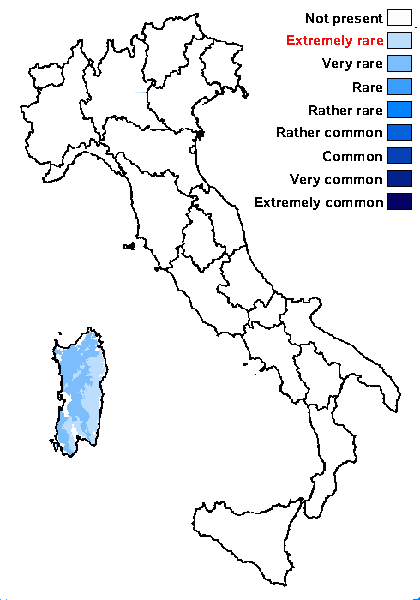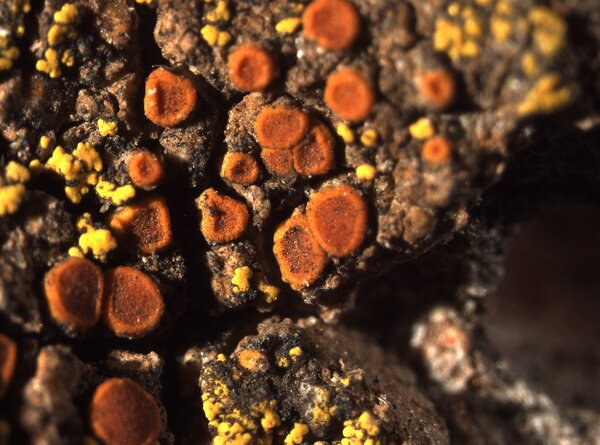Athallia vitellinaria (Szatala) ined.
provisionally placed here, ICN Art. 36.1b. . Basionym: Caloplaca vitellinaria Szatala - Annls Mus. natn. Hung., n.s., 7: 276, 1956
Synonyms:
Distribution: C - Sar (TSB 9635).
Description: Thallus not evident or crustose, orange, very much reduced and visible only around the apothecia, developing on silicicolous species of Candelariella, especially C. vitellina. Medulla I-. Apothecia zeorine, usually numerous and clustered, round to angular by mutual compression, (0.3-)0.5-1(1.5) mm across, with a flat to slightly convex, orange disc, a thin, slightly paler, only initially raised, finally sometimes excluded margin and sometimes a poorly developed thalline margin visible only on the underside of young apothecia. Thalline exciple rich in algae, orange in outer part; proper exciple of radiating hyphae; epithecium golden brown to orange, finely granular, K+ purple-red, C-; hymenium colourless, 60-100(-125) μm high, I+ blue; paraphyses simple or branched in upper part, 2-2.5 μm thick at mid-level, the apical cells swollen, to 5 μm wide; hypothecium colourless, c. 30 μm high, I-. Asci 8-spored, cylindrical, functionally unitunicate, apically thickened with a broad internal beak, the inner part of apex and external cap I+ blue, Teloschistes-type. Ascospores 2-celled, polarilocular, hyaline, ellipsoid to broadly ellipsoid, 9-15 x 5-8 μm, the equatorial thickening (“septum”) (3-)4-5(-6) μm, c. 1/3 of spore length. Photobiont chlorococcoid. Spot tests: thallus K- or K+ purple-red, C-, KC-, P-; apothecia K+ purple-red, C-. Chemistry: unknown but probably apothecia and orange-pigmented parts of thallus (when present) with parietin (major), fallacinal, emodin, teloschistin and parietinic acid (minor).Note: a species parasitic on the thallus of silicicolous Candelariella-species, especially Candelariella vitellina, widespread in Central and Southern Europe but apparently rare, perhaps confused with Athallia holocarpa. The species was provisionally combined into Athallia by Roux, but the combination is invalid.
Growth form: Crustose
Substrata: rocks
Photobiont: green algae other than Trentepohlia
Reproductive strategy: mainly sexual
paras Candelariella-species
Commonnes-rarity: (info)
Alpine belt: absent
Subalpine belt: extremely rare
Oromediterranean belt: extremely rare
Montane belt: extremely rare
Submediterranean belt: extremely rare
Padanian area: absent
Humid submediterranean belt: very rare
Humid mediterranean belt: absent
Dry mediterranean belt: absent

Predictive model
Herbarium samples
Growth form: Crustose
Substrata: rocks
Photobiont: green algae other than Trentepohlia
Reproductive strategy: mainly sexual
paras Candelariella-species
Commonnes-rarity: (info)
Alpine belt: absent
Subalpine belt: extremely rare
Oromediterranean belt: extremely rare
Montane belt: extremely rare
Submediterranean belt: extremely rare
Padanian area: absent
Humid submediterranean belt: very rare
Humid mediterranean belt: absent
Dry mediterranean belt: absent

Predictive model
| Herbarium samples |





